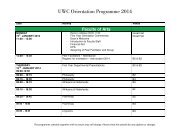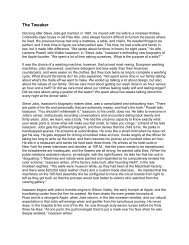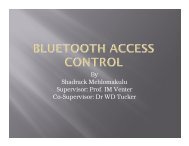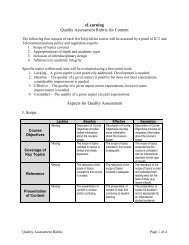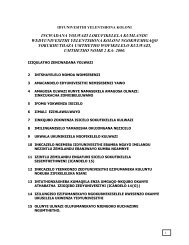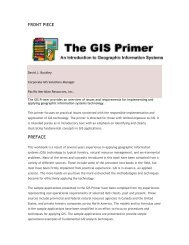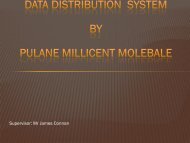Ecosystem Guidelines for Environmental Assessment
Ecosystem Guidelines for Environmental Assessment
Ecosystem Guidelines for Environmental Assessment
Create successful ePaper yourself
Turn your PDF publications into a flip-book with our unique Google optimized e-Paper software.
FRESHWATER<br />
FRESHWATER<br />
ECOSYSTEMS: WETLANDS<br />
Liz Day and Nancy Job<br />
INWARD-DRAINING (ENDORHEIC) WETLANDS - many of these receive water directly from precipitation<br />
or groundwater seepage. The category is further divided into permanently and seasonally inundated<br />
basins, and includes salt pans and reed and sedge pans<br />
RIVERINE WETLANDS - including riparian fringes, seepage lines, floodplains and river source sponge areas<br />
LACUSTRINE (LAKE-LIKE) WETLANDS - including coastal lakes, permanent and temporary freshwater<br />
pans, blackwater lakelets<br />
PALUSTRINE WETLANDS - including seasonal and permanent marshes and swamps, springs, sedge,<br />
restio and reedbed marshes and Cape fynbos seasonal wetlands<br />
ARTIFICIAL WETLANDS - including dammed or drowned basins within river catchments<br />
ESTUARINE AND LAGOONAL WETLANDS - see Guideline 1, Coastal <strong>Ecosystem</strong>s p.24<br />
What are the key ecological “drivers” in terms of<br />
maintaining ecosystem function, pattern or structure<br />
Water quantity and flow regime, including surface and groundwater sources.<br />
Water quality.<br />
Geology and soil type and structure.<br />
Biological processes, affecting biotope quality and availability.<br />
What are the key challenges affecting management<br />
General lack of knowledge as to how many systems function, their biodiversity and their links to other<br />
systems.<br />
Inadequate implementation of existing laws and policies aimed at protecting wetland resources and<br />
ecosystems.<br />
Integration of social / political and economic imperatives with ecological ones.<br />
Maintenance of:<br />
- natural or near-natural hydrological regime - including hydrological linkages throughout the<br />
catchment and seasonal or permanent links with groundwater.<br />
- natural or near-natural water quality.<br />
- natural erosion and sedimentation processes.<br />
- function - e.g. water quality amelioration; infiltration; floodwater retention, provision of low flows<br />
to downstream users.<br />
- maintenance of biological connectivity in the catchment and in the broader system - including<br />
potential ecological linkages with terrestrial ecosystems (e.g. pollinators, seed dispersers).<br />
- specific habitat quality and availability (genetic integrity, including biodiversity).<br />
- maintenance of genetic integrity.<br />
Co-ordination of management interventions at a catchment scale so as to maximise the potential <strong>for</strong><br />
achieving and sustaining all of the above objectives.<br />
Integration of ecological and social objectives, so that improvement to one is not at the expense of<br />
the other.<br />
COLIN PATERSON-JONES<br />
68 : FRESHWATER ECOSYSTEMS - WETLANDS



